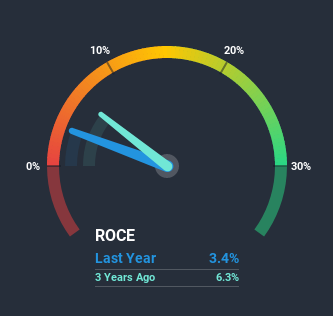
What are the early trends we should look for to identify a stock that could multiply in value over the long term? Firstly, we'd want to identify a growing return on capital employed (ROCE) and then alongside that, an ever-increasing base of capital employed. This shows us that it's a compounding machine, able to continually reinvest its earnings back into the business and generate higher returns. However, after briefly looking over the numbers, we don't think Yoshitake (TYO:6488) has the makings of a multi-bagger going forward, but let's have a look at why that may be.
What is Return On Capital Employed (ROCE)?
Just to clarify if you're unsure, ROCE is a metric for evaluating how much pre-tax income (in percentage terms) a company earns on the capital invested in its business. The formula for this calculation on Yoshitake is:
Return on Capital Employed = Earnings Before Interest and Tax (EBIT) ÷ (Total Assets - Current Liabilities)
0.034 = JP¥431m ÷ (JP¥14b - JP¥904m) (Based on the trailing twelve months to December 2020).
So, Yoshitake has an ROCE of 3.4%. In absolute terms, that's a low return and it also under-performs the Machinery industry average of 6.4%.
See our latest analysis for Yoshitake

Historical performance is a great place to start when researching a stock so above you can see the gauge for Yoshitake's ROCE against it's prior returns. If you'd like to look at how Yoshitake has performed in the past in other metrics, you can view this free graph of past earnings, revenue and cash flow.
What Does the ROCE Trend For Yoshitake Tell Us?
In terms of Yoshitake's historical ROCE trend, it doesn't exactly demand attention. The company has consistently earned 3.4% for the last five years, and the capital employed within the business has risen 20% in that time. Given the company has increased the amount of capital employed, it appears the investments that have been made simply don't provide a high return on capital.
The Bottom Line
In summary, Yoshitake has simply been reinvesting capital and generating the same low rate of return as before. Although the market must be expecting these trends to improve because the stock has gained 86% over the last five years. However, unless these underlying trends turn more positive, we wouldn't get our hopes up too high.
On a final note, we've found 2 warning signs for Yoshitake that we think you should be aware of.
While Yoshitake isn't earning the highest return, check out this free list of companies that are earning high returns on equity with solid balance sheets.
When trading Yoshitake or any other investment, use the platform considered by many to be the Professional's Gateway to the Worlds Market, Interactive Brokers. You get the lowest-cost* trading on stocks, options, futures, forex, bonds and funds worldwide from a single integrated account. Promoted
New: Manage All Your Stock Portfolios in One Place
We've created the ultimate portfolio companion for stock investors, and it's free.
• Connect an unlimited number of Portfolios and see your total in one currency
• Be alerted to new Warning Signs or Risks via email or mobile
• Track the Fair Value of your stocks
This article by Simply Wall St is general in nature. It does not constitute a recommendation to buy or sell any stock, and does not take account of your objectives, or your financial situation. We aim to bring you long-term focused analysis driven by fundamental data. Note that our analysis may not factor in the latest price-sensitive company announcements or qualitative material. Simply Wall St has no position in any stocks mentioned.
*Interactive Brokers Rated Lowest Cost Broker by StockBrokers.com Annual Online Review 2020
Have feedback on this article? Concerned about the content? Get in touch with us directly. Alternatively, email editorial-team (at) simplywallst.com.
About TSE:6488
Yoshitake
Manufactures and sells fluid control valves in Japan and internationally.
Excellent balance sheet, good value and pays a dividend.
Market Insights
Community Narratives



